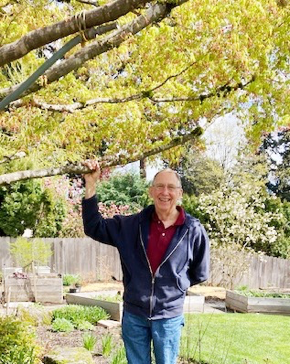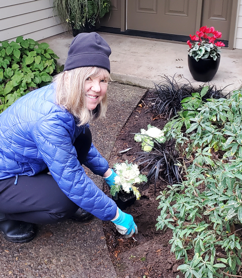Written by Beverly Briggs
Chickadees making a nest in the bird box. Hummingbirds flocking to the red flowering currant. Scrub jays fluffing their feathers in the bird bath. Mason bees emerging and doing their thing. These are pleasures happening right now in our backyards.
The Backyard Habitat Certification Program, co-managed by Portland Audubon and Columbia Land Trust, is an effort to conserve and restore land throughout our region. The goal is for us to create natural habitat in our outdoor spaces to provide places for birds to sing, bees to pollinate, and native plants to grow. To assist in the effort are Backyard Habitat criteria that can be used to guide us in making changes in our yards.
Several St. Andrew Lutheran Church members have certified Backyard Habitats. Each followed the criteria, available on-line, to study their yards. They enrolled in the program, were visited by a Backyard Habitat Technician, and received their thorough site reports with suggestions for more plants and other additions. They’ve all reached certification and received their metal certification signs and certificates.

LuAnn learned about the Backyard Habitat program from her involvement with the St. Andrew Earth Care Team. As she studied the certification criteria, she discovered that she had a head start. Her yard is anchored with two large native Oregon White Oaks, and she already had water collection barrels and a habitat for mason bees, and was providing food and water for the birds. To prepare, LuAnn removed all of the invasive plants, including a five-foot English Holly!
She was surprised to learn during her visit that some of the plants she thought were native were not, but she was glad to receive recommendations for native plants that would blend nicely with her already established ornamental plants. Since receiving her Gold level certification, she has planted a small native tree and native shrubs, ground covers and ferns. She is hoping to move up to the Platinum level on her next visit.
“This is about making changes to your yard that go beyond just planting native plants. It includes changing how you approach resources for wildlife with water and lighting, creating habitat for birds, and taking a natural approach to pest control. It does not require that you eliminate the beautiful non-native plants you already have.” LuAnn is most willing to help others select native plants and make other changes that will “turn their yards into conservation corridors to provide wildlife habits and impact climate change.”

Liz has known about Backyard Habitat for quite awhile. As a member of the St. Andrew Earth Care Team, she decided that becoming certified was her way to do her part in “bringing the natural world back to the way that it should be.” As she studied the criteria, she knew that her yard was pretty much ready for certification.
Before her initial site visit, Liz planted even more native plants and removed the invasive Vinca (not an easy task). She found her Backyard Habitat technician to be helpful and informative. Liz was not surprised to be certified during her initial visit at the Silver certification level, but she WAS surprised to learn that the only thing keeping her from getting a Gold level certification was her Butterfly Bush (another invasive weed.) Her technician gave her some ideas about removing it and suggested native plants to replace it. Liz is eager to take those steps and request a follow up visit.
She is interested in helping others enroll and is working with her neighbor to design a common natural habitat between their houses.

Beverly learned about the Backyard Habitat program in a gardening workshop. She was further inspired when Clean Water Services and Tualatin Hills Park and Recreation restored the wetland that borders her backyard. She began adding the same native plants that they were placing in the wetland. It just seemed to be a natural next step to enroll in the Backyard Habitat Certification Program. Her biggest struggle is keeping the Himalayan Blackberry vines at bay, which creep over into her yard from the wetland.
She was pleasantly surprised to be certified at the Gold level during her initial site visit, with not much to do to get to the Platinum level. Plant a native large canopy tree, remove invasive Vinca and Creeping Jenny, add a bird box, and plant more native plants. She hopes to be ready to request a visit with a volunteer in the fall. (The blackberries take continual vigilance.)
Beverly actively consults with her neighbors, who are interested in planting more native plants. Her Certified Backyard Habitat sign is posted at the edge of her front yard, and she sees walkers stopping and taking a look.

Rob thinks he learned about the Backyard Habitat program through a notice from Tualatin Valley Water District. Without much hesitation or preparation, he jumped right in and enrolled. At his initial site visit, his technician identified non-native plants (many which he subsequently decided to remove) and admired many of his ornamental landscape plants.
His yard has received Silver certification. He is happy with his Silver certification and knows that if he would want to move to another level, he would need to find alternatives to particular products and commercial fertilizers.
Rob’s certification sign might have been the inspiration for his across-the-street neighbor to enroll and reach certification!

Michelle began to notice the Backyard Habitat signs when she took walks in her neighborhood after she moved to the Portland area. She describes their yard at the time as being “a horticultural wasteland” with weeds and lots of grass. She got to work and took out much of the grass and planted trees and shrubs. As she explained, “Growing things has been a part of my family history. It fits with me theologically—caring for creation. I feel like it is congruent and fits with all of my life.”
She was “shocked” to be awarded a Silver level certification after her technician’s initial site visit. She will probably want to move up to the next level of certification, but her joy is just being outside. She plans to add more native plants, take out more of the grass, continue to add layers, and reduce pesticide use, but take it slowly, year by year.
She focuses her energy on her Home Owners’ Association, informing them of the Backyard Habitat program, and hoping to help her neighbors and perhaps the whole HOA become certified.
Her advice to those who are interested: “(Certification) isn’t as hard as I thought it would be. You don’t have to be a purist. You can still have other non-native plants and things you like.”